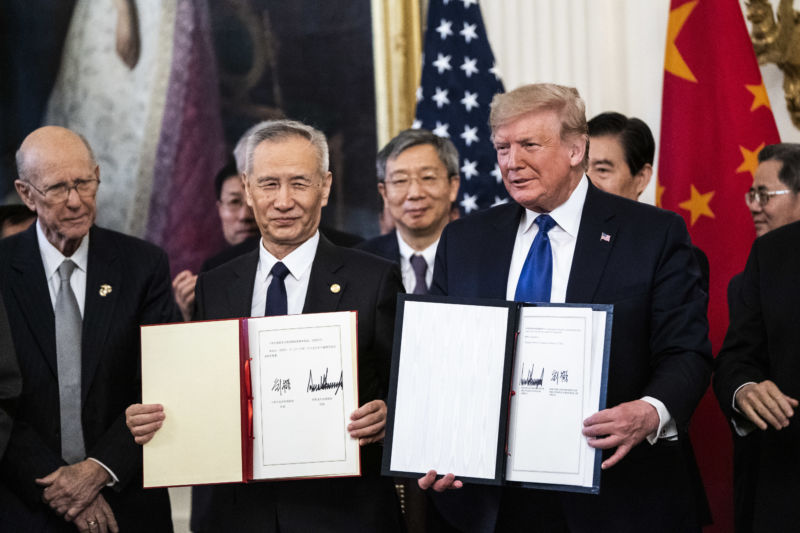
After years of posturing, tariffs, retaliation, and heated rhetoric, United States and China officials this week finally signed off on a new trade deal that should allow tech businesses and consumers to avoid steep tariffs on electronics and other goods that would otherwise have taken effect this coming weekend.
The full agreement (PDF) is principally focused on the agricultural sector. US farmers, unable to export their goods to the country’s largest trade partner, faced significant losses from the trade standoff, and the administration spent billions on agricultural bailouts.
Under the terms of the new deal, China will purchase an additional $200 billion worth of US goods and services over the next two years. Experts estimate that US exports to China this year would pass the $260 billion mark in the next 12 months.
The arrangement also agrees to ease existing tariffs on several categories of imported goods and avoid adding them to others. Tariffs on about $120 billion in goods will also be cut in half from their current level of 15 percent to 7.5 percent. The list (PDF) of items currently being taxed at that 15 percent rate includes several tech products, such as televisions, headsets and earbuds, smart speakers, and smart watches.
Other consumer electronics, including laptop and tablet computers, monitors and other peripherals, video game consoles, and smartphones were slated to face a new 25-percent tariff rate in December. The video game industry, among others, asked the administration (PDF) to exempt its products from the tariffs, arguing at the time that the resulting price increases would “injure consumers, video game developers, retailers, and console manufacturers; put thousands of high-value, rewarding US jobs at risk; and stifle innovation in our industry and beyond.”
Those tech tariffs have been staved off, but most previously imposed tariffs will remain in place. That includes the extra 25-percent duties added in 2018 to imports on semiconductors, modems, and some other tech components.
One analysis found that US importers have paid about $46 billion in the new taxes since 2018. These costs ultimately get passed along the line to individual consumers. About two-thirds of all imports from China fall into that bucket, The Washington Post reports.
Tech transfer
In addition to changing the rates at which certain goods are taxed, the new agreement includes chapters surrounding intellectual property and the forced transfer of technology.
It is not uncommon for China to require foreign companies to work through joint ventures that, in turn, transfer sensitive internal technology—trade secrets, basically—to local Chinese firms. US and other international companies agree to such terms as a condition for entering the lucrative Chinese market.
The new trade agreement severely curtails that practice, saying that any transfer or licensing terms between US and China firms “must be based on market terms that are voluntary and reflect mutual agreement.” Neither party to the agreement, meaning the United States and China, “shall require or pressure, formally or informally, persons [including corporations] of the other party to transfer technology to its persons as a condition” of receiving permission to operate in the other party’s market, the agreement says.
The pact also addresses intellectual property theft. Under the terms of the deal, China agrees to enact measures to limit “trade secret misappropriation,” including when it happens through electronic intrusions, systems breaches, and flat-out “unauthorized disclosure.” The agreement does not require the US to strengthen its trade secret law, instead saying the US “affirms that existing US measures afford treatment equivalent” to the terms of the new deal.









